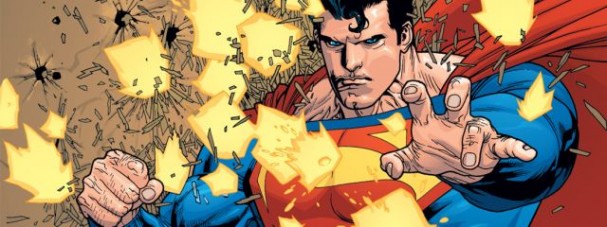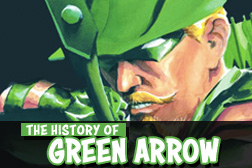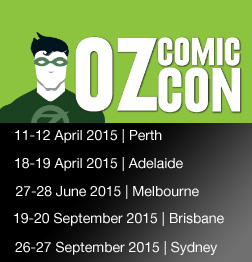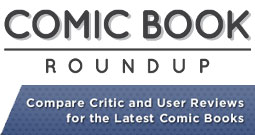With Man of Steel now out in cinemas around the world, comics fans and non-readers alike may be looking for a place to start reading the further adventures of Superman. This is, after all, the 75th anniversary of the Big Red S, and there’s a world of stories out there.
Some stories are essential reads, others are more forgettable, but the ones we have selected here all stand out for one reason or another. Whether they are definitive retellings of the origin of last son of Krypton, or perhaps just controversial for their dramatic liberties, they have all had us talking at one time or another.
Agree or disagree? Got a comment? Start a conversation below, or take it with you on Behind the Panel’s Facebook and Twitter!
If you are an iTunes user, subscribe to our weekly podcast free here and please leave us feedback.
Superman: Birthright (2003/2004)
 Superman’s origin story had been told in countless forms by the time writer Mark Waid and artist Leinil Yu tackled the project, its aim to tell a definitive version of Superman’s birth for the 21st century. This was a project that Waid had wanted to be involved in since seeing Superman: The Movie (1978), and has connections with the “Superman Now” project of 1998 with Grant Morrison, Mark Millar, and Tom Peyer. Of course, while Morrison went on to All-Star Superman years later, Waid managed to release this canonical run on the character that defines everything that it means to be a hero. It sees a young Clark wandering the world before donning his costume, covering stories as a journalist in West Africa, slowly realising that with great power comes great responsibility. It not only makes Clark Kent/Kal-El more of a global presence, but a rich and layered human that has complicated emotions that he masks as both the bumbling Clark Kent and the beacon of hope that is Superman. Fans of the recent film will find similarities in the Kryptonian scenes, and the “alien commander” Van-Gar. David S. Goyer and Zack Snyder use a similar motif as Kal-El’s catalyst in the film of Man of Steel, although it also gives us a classic villain in Lex Luthor, and the reality of the alien threat is very different in each version. This series, collected as a trade paperback, is a joy to read and briefly enjoyed canonical status before that was squished by Infinite Crisis. It was replaced by Superman: Secret Origin only a few years later, but it stands as a fantastic example of how to modernise the Man of Steel without losing that which makes him heroic.
Superman’s origin story had been told in countless forms by the time writer Mark Waid and artist Leinil Yu tackled the project, its aim to tell a definitive version of Superman’s birth for the 21st century. This was a project that Waid had wanted to be involved in since seeing Superman: The Movie (1978), and has connections with the “Superman Now” project of 1998 with Grant Morrison, Mark Millar, and Tom Peyer. Of course, while Morrison went on to All-Star Superman years later, Waid managed to release this canonical run on the character that defines everything that it means to be a hero. It sees a young Clark wandering the world before donning his costume, covering stories as a journalist in West Africa, slowly realising that with great power comes great responsibility. It not only makes Clark Kent/Kal-El more of a global presence, but a rich and layered human that has complicated emotions that he masks as both the bumbling Clark Kent and the beacon of hope that is Superman. Fans of the recent film will find similarities in the Kryptonian scenes, and the “alien commander” Van-Gar. David S. Goyer and Zack Snyder use a similar motif as Kal-El’s catalyst in the film of Man of Steel, although it also gives us a classic villain in Lex Luthor, and the reality of the alien threat is very different in each version. This series, collected as a trade paperback, is a joy to read and briefly enjoyed canonical status before that was squished by Infinite Crisis. It was replaced by Superman: Secret Origin only a few years later, but it stands as a fantastic example of how to modernise the Man of Steel without losing that which makes him heroic.
Superman: Secret Origin (2009/2010)
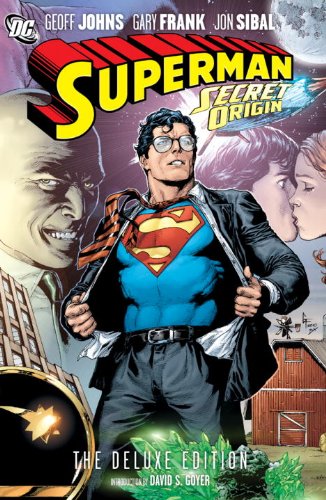 Following Infinite Crisis, this was the new “definitive” retelling of the Man of Steel’s origin. We actually covered this one all the way back on Issue #6 of the Behind the Panels podcast, and had mixed feelings about it. It’s a very traditional retelling by Geoff Johns and artist Gary Frank, sticking very closely to what we know about Superman’s birth and formative years. Johns can’t help but indulge in his own fan-service, having recently stepped off both Superman and the Legion of Super-Heroes and Brainiac, with both sets of characters appearing in the six-issue collection. These sidesteps somewhat undermine the main story, coming more from a love of the 1950s Superboy stories than from any other narrative reason. It negates the feelings of isolation that Clark might be feeling from his growing abilities in small-town Kansas. Naturally, the story ends up in Metropolis, this time battling Lex, Metallo and Brainiac before finding a home at both the Daily Planet and the planet Earth. Despite these indulgences, it’s easy to recommend this to new readers as a place to start. Unlike television’s Smallville or Birthright, it sticks to the story as most people would remember it, so it won’t challenge or disturb. It’s classic Superman, it has a sense of joy and some terrific art from Gary Frank.
Following Infinite Crisis, this was the new “definitive” retelling of the Man of Steel’s origin. We actually covered this one all the way back on Issue #6 of the Behind the Panels podcast, and had mixed feelings about it. It’s a very traditional retelling by Geoff Johns and artist Gary Frank, sticking very closely to what we know about Superman’s birth and formative years. Johns can’t help but indulge in his own fan-service, having recently stepped off both Superman and the Legion of Super-Heroes and Brainiac, with both sets of characters appearing in the six-issue collection. These sidesteps somewhat undermine the main story, coming more from a love of the 1950s Superboy stories than from any other narrative reason. It negates the feelings of isolation that Clark might be feeling from his growing abilities in small-town Kansas. Naturally, the story ends up in Metropolis, this time battling Lex, Metallo and Brainiac before finding a home at both the Daily Planet and the planet Earth. Despite these indulgences, it’s easy to recommend this to new readers as a place to start. Unlike television’s Smallville or Birthright, it sticks to the story as most people would remember it, so it won’t challenge or disturb. It’s classic Superman, it has a sense of joy and some terrific art from Gary Frank.
All-Star Superman (2005-2008)
 Grant Morrison‘s saga is, in many ways, the definitive Superman story of all time. It is a complete Superman story, and by it’s very nature, the last Superman story that anybody will ever need. First released between 2005 and 2008, Grant Morrison and Frank Quitely‘s 12-issue All-Star Superman series began life as the aforementioned reboot project called “Superman Now”. Overwhelmed with solar radiation, Superman gains new powers, but those same powers are also killing him. Winner of three Eisner Awards, it asks the simple question: how would Superman spend his last days on Earth? Stripping the Man of Steel down to his most heroic of essentials, it was reportedly inspired by what Morrison calls a “shamanic vision” in San Diego, of a man dressed as Superman wandering across the railway tracks. The relaxed and sauntering nature of the man led Morrison to believe that the most powerful man on Earth would be super relaxed, and this translates into Quitely’s singularly stunning artwork. If anything would stop us from recommending this to a new reader, it is the book’s ultimate conclusion, but even this is easy to reconile when the writing is this good. Like Morrison’s run on Batman, it almost imagines every version of Superman from the 1930s through to the 2000s as being the same, and is simultaneously an action movie, a love story and a contemplation on what it means to be a hero. Above all things, it is a heartfelt tribute to the most iconic costumed hero of all time, and proof that it is possible to find new angles on the classics after seven decades. We discuss this one in much more detail on issue #61 of the Behind the Panels podcast.
Grant Morrison‘s saga is, in many ways, the definitive Superman story of all time. It is a complete Superman story, and by it’s very nature, the last Superman story that anybody will ever need. First released between 2005 and 2008, Grant Morrison and Frank Quitely‘s 12-issue All-Star Superman series began life as the aforementioned reboot project called “Superman Now”. Overwhelmed with solar radiation, Superman gains new powers, but those same powers are also killing him. Winner of three Eisner Awards, it asks the simple question: how would Superman spend his last days on Earth? Stripping the Man of Steel down to his most heroic of essentials, it was reportedly inspired by what Morrison calls a “shamanic vision” in San Diego, of a man dressed as Superman wandering across the railway tracks. The relaxed and sauntering nature of the man led Morrison to believe that the most powerful man on Earth would be super relaxed, and this translates into Quitely’s singularly stunning artwork. If anything would stop us from recommending this to a new reader, it is the book’s ultimate conclusion, but even this is easy to reconile when the writing is this good. Like Morrison’s run on Batman, it almost imagines every version of Superman from the 1930s through to the 2000s as being the same, and is simultaneously an action movie, a love story and a contemplation on what it means to be a hero. Above all things, it is a heartfelt tribute to the most iconic costumed hero of all time, and proof that it is possible to find new angles on the classics after seven decades. We discuss this one in much more detail on issue #61 of the Behind the Panels podcast.
Superman: Earth One (2010)
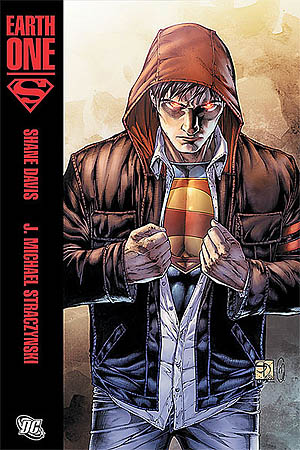 Written by written by J. Michael Straczynski and illustrated by Shane Davis, it was the first original graphic novel under the Earth One banner. Intended as something of a continuity-free version of DC characters, much like Marvel’s Ultimate universe, new readers might enjoy this version as it has a number of significant ties to the Man of Steel film. Like the new film, it sees a Clark/Kal-El reluctant to embrace his superpowers and reveal himself to the world. As with Birthright, it is an alien invasion that serves as the impetus for finally donning the costume. However, here it is neither General Zod or a fictitious group of ships conjured by Luthor. Instead, it is Tyrell from the planet Dheron, an old foe of Krypton’s. Some of the book’s problems mirror those of the new film, in that Kent is more emo than hero, and his angst occasionally burdens the story rather than layering it. Last year, a second volume was released by the same creative team, to even more critical success. Other books within the Earth One universe include Batman: Earth One, and forthcoming volumes for Wonder Woman and Nightwing of all people. Definitely worth a read for people who like their Superman without ties to the rest of the DCU.
Written by written by J. Michael Straczynski and illustrated by Shane Davis, it was the first original graphic novel under the Earth One banner. Intended as something of a continuity-free version of DC characters, much like Marvel’s Ultimate universe, new readers might enjoy this version as it has a number of significant ties to the Man of Steel film. Like the new film, it sees a Clark/Kal-El reluctant to embrace his superpowers and reveal himself to the world. As with Birthright, it is an alien invasion that serves as the impetus for finally donning the costume. However, here it is neither General Zod or a fictitious group of ships conjured by Luthor. Instead, it is Tyrell from the planet Dheron, an old foe of Krypton’s. Some of the book’s problems mirror those of the new film, in that Kent is more emo than hero, and his angst occasionally burdens the story rather than layering it. Last year, a second volume was released by the same creative team, to even more critical success. Other books within the Earth One universe include Batman: Earth One, and forthcoming volumes for Wonder Woman and Nightwing of all people. Definitely worth a read for people who like their Superman without ties to the rest of the DCU.
Superman: Red Son (2003)
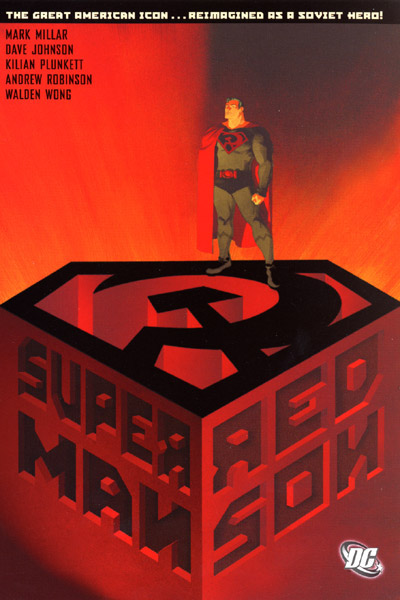 Is Superman American or a citizen of the world? Almost every version of the Man of Steel’s origin triumphs his upbringing in rural Kansas as a reason for his wholesome attitude towards helping others. What if he landed elsewhere? An alternate universe where Kal-El’s pod lands on Earth a few hours out of whack with our familiar version, he grows up in a Ukranian farm collective to become “the Champion of the common worker who fights a never-ending battle for Stalin, socialism, and the international expansion of the Warsaw Pact.” Familiar faces are subverted in a world where the nuclear arms race is replaced by a superhuman struggle, and CIA agent Jimmy Olsen recruits Lex Luthor to come with a means of destroying Superman. Released as a 3-issue Elseworlds series in 2003, it came a few years after writer Mark Millar’s re-imagining of the Marvel universe in The Ultimates. Spanning an alternate Earth history from 1953 to 2001, along with a glimpse into the future, the series was just as instrumental as the later All-Star Superman in reminding readers what it means to be a superhero.
Is Superman American or a citizen of the world? Almost every version of the Man of Steel’s origin triumphs his upbringing in rural Kansas as a reason for his wholesome attitude towards helping others. What if he landed elsewhere? An alternate universe where Kal-El’s pod lands on Earth a few hours out of whack with our familiar version, he grows up in a Ukranian farm collective to become “the Champion of the common worker who fights a never-ending battle for Stalin, socialism, and the international expansion of the Warsaw Pact.” Familiar faces are subverted in a world where the nuclear arms race is replaced by a superhuman struggle, and CIA agent Jimmy Olsen recruits Lex Luthor to come with a means of destroying Superman. Released as a 3-issue Elseworlds series in 2003, it came a few years after writer Mark Millar’s re-imagining of the Marvel universe in The Ultimates. Spanning an alternate Earth history from 1953 to 2001, along with a glimpse into the future, the series was just as instrumental as the later All-Star Superman in reminding readers what it means to be a superhero.
The Man of Steel (1986)
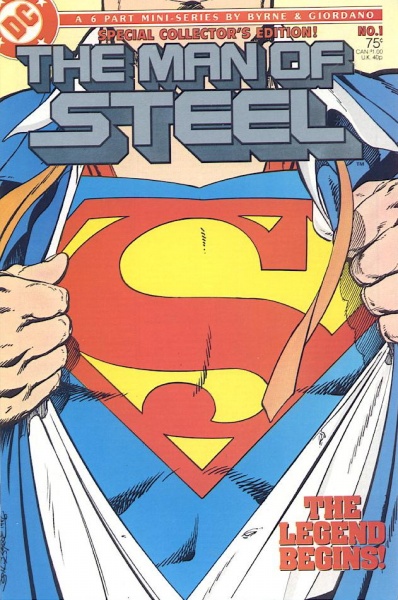 Before the film Man of Steel, there was John Byrne’s The Man of Steel. In many ways, this was the first major Superman retelling in decades, and coincided with Crisis on Infinite Earths, which effectively rebooted the entire DC Comics line. Sometimes controversial and divisive, Byrne stripped Superman back to his barest of essentials. Gone was his career as Superboy and the menagerie of animals that came with it. Clark Kent was a real person, and Superman was his disguise. His powers weren’t as limitless and previous (and subsequent) depictions might have led us to believe. A major success in its day, with the first issue selling 200,000 copies, the six-issue limited series remained the official canonical origin story for Superman for over 20 years, eventually ending with Superman: Secret Origin replacing it in 2009, and later The New 52 in 2011. Along with an ongoing series, Byrne followed this with three four-issue mini-series that retold and explored the new post-Crisis world of Superman: The World of Krypton, The World of Smallville, and The World of Metropolis. If you read this after watching the Man of Steel film, you will definitely notice one device they have in common: the Kryptonian birthing pods where life is grown. It was one of the major sticking points for some fans, ensuring that Superman may have been “conceived” on Krypton, but “born” on Earth.
Before the film Man of Steel, there was John Byrne’s The Man of Steel. In many ways, this was the first major Superman retelling in decades, and coincided with Crisis on Infinite Earths, which effectively rebooted the entire DC Comics line. Sometimes controversial and divisive, Byrne stripped Superman back to his barest of essentials. Gone was his career as Superboy and the menagerie of animals that came with it. Clark Kent was a real person, and Superman was his disguise. His powers weren’t as limitless and previous (and subsequent) depictions might have led us to believe. A major success in its day, with the first issue selling 200,000 copies, the six-issue limited series remained the official canonical origin story for Superman for over 20 years, eventually ending with Superman: Secret Origin replacing it in 2009, and later The New 52 in 2011. Along with an ongoing series, Byrne followed this with three four-issue mini-series that retold and explored the new post-Crisis world of Superman: The World of Krypton, The World of Smallville, and The World of Metropolis. If you read this after watching the Man of Steel film, you will definitely notice one device they have in common: the Kryptonian birthing pods where life is grown. It was one of the major sticking points for some fans, ensuring that Superman may have been “conceived” on Krypton, but “born” on Earth.
A Superman For All Seasons (1998)
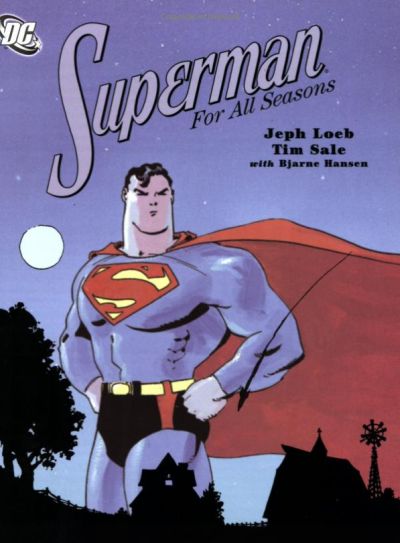 Fresh off their success with the superb Batman: The Long Halloween (1996-1997), itself dealing with the early days of the Dark Knight, Jeph Loeb and Tim Sale’s A Superman For All Seasons aimed to portray Superman as an icon. Using a similar motif to their previous holiday-themed work, the four parts of this tale use the seasons as their framework, crafting a coming of age story that ultimately leads to an acceptance of one’s place in the world. Choosing not to try and get inside the head of Superman, each chapter is narrated by someone who has impacted on Superman/Clark/Kal-El’s life in some way: Jonathan Kent (Spring), Lois Lane (Summer), Lex Luthor (Autumn) and Lana Lang (Winter). This is different to the other books here in that it is not another origin retelling, but rather something that could easily run alongside The Man of Steel or Mark Waid’s Birthright for that matter. It is Superman through the eyes of those that watched him become the hero he was destined to be. Tim Sale’s art is reportedly inspired by Normal Rockwell, presenting Superman in the most majestic of backgrounds, giving us the unsullied ideal rather than the grittier modern versions. Some at DC Comics have described this as the inspiration for television’s Smallville, a series on which writer Jeph Loeb served as an executive producer.
Fresh off their success with the superb Batman: The Long Halloween (1996-1997), itself dealing with the early days of the Dark Knight, Jeph Loeb and Tim Sale’s A Superman For All Seasons aimed to portray Superman as an icon. Using a similar motif to their previous holiday-themed work, the four parts of this tale use the seasons as their framework, crafting a coming of age story that ultimately leads to an acceptance of one’s place in the world. Choosing not to try and get inside the head of Superman, each chapter is narrated by someone who has impacted on Superman/Clark/Kal-El’s life in some way: Jonathan Kent (Spring), Lois Lane (Summer), Lex Luthor (Autumn) and Lana Lang (Winter). This is different to the other books here in that it is not another origin retelling, but rather something that could easily run alongside The Man of Steel or Mark Waid’s Birthright for that matter. It is Superman through the eyes of those that watched him become the hero he was destined to be. Tim Sale’s art is reportedly inspired by Normal Rockwell, presenting Superman in the most majestic of backgrounds, giving us the unsullied ideal rather than the grittier modern versions. Some at DC Comics have described this as the inspiration for television’s Smallville, a series on which writer Jeph Loeb served as an executive producer.
Superman: Whatever Happened to the Man of Tomorrow? (1986)
 It’s a good question, and one that renegade Northampton genius Alan Moore wanted answered in 1986. Once again, inspired by Crisis on Infinite Earths, this was originally published as a two-part story in Superman # 423 and ending in Action Comics #583. As John Byrne would soon be rebooting the Superman mythos in the aforementioned The Man of Steel, Moore and outgoing editor Julius Schwartz imagined that these two issues were the last Superman issues ever. During the story, it has been ten years since Superman was seen, and Lois Lane-Elliot is the last person to have seen him alive. This moving and timeless story is actually the “death of Superman”, or at least the death of the Silver Age version of him. Moore went through every version of Superman’s lore that he could find to bring a fitting end to the character, and it is tough to find a dry eye left as the second part comes to its conclusion. Closing the door on a bygone era, it was no mistake that Schwartz chose definitive Superman artist Curt Swan, who has been drawing the character in various publications since 1948, to pencil the issue. With the legendary George Pérez and Kurt Schaffenberger on inks, this is a labour of love from all involved, and essential reading for any self-respecting comics fan. It’s also an interesting one to read in tandem with All-Star Superman.
It’s a good question, and one that renegade Northampton genius Alan Moore wanted answered in 1986. Once again, inspired by Crisis on Infinite Earths, this was originally published as a two-part story in Superman # 423 and ending in Action Comics #583. As John Byrne would soon be rebooting the Superman mythos in the aforementioned The Man of Steel, Moore and outgoing editor Julius Schwartz imagined that these two issues were the last Superman issues ever. During the story, it has been ten years since Superman was seen, and Lois Lane-Elliot is the last person to have seen him alive. This moving and timeless story is actually the “death of Superman”, or at least the death of the Silver Age version of him. Moore went through every version of Superman’s lore that he could find to bring a fitting end to the character, and it is tough to find a dry eye left as the second part comes to its conclusion. Closing the door on a bygone era, it was no mistake that Schwartz chose definitive Superman artist Curt Swan, who has been drawing the character in various publications since 1948, to pencil the issue. With the legendary George Pérez and Kurt Schaffenberger on inks, this is a labour of love from all involved, and essential reading for any self-respecting comics fan. It’s also an interesting one to read in tandem with All-Star Superman.
Last Son (2006 – 2008)
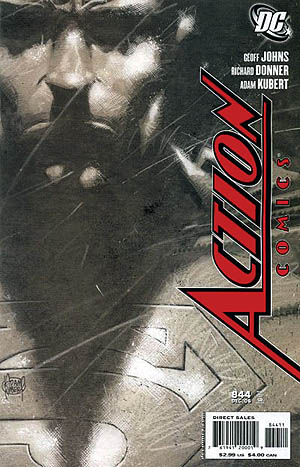 A rocket ship carrying a baby crash-lands on Earth, a story that should by now be familiar to all. Yet this isn’t the story we know. Commencing with Action Comics #844 in 2006, Geoff Johns teamed with Superman: The Movie director Richard Donner to bring us something that has be described by some as the “true” Superman III. The young boy is Kryptonian, and fearing what his appearance in Metropolis will mean, he is taken and adopted by Clark Kent and Lois Lane, named Chris and raised by the couple. Who would have thought that Superman could be so controversial? So many of the books on this list have divided fans, and the character of Chris Kent raised a whole lot of issues, not least of which was his continuity discrepancies. During the writing, Adam Kubert suffered from health problems, pushing the conclusion of the book back 19 months and concluding in Action Comics #851 and the eleventh annual. It marked the first appearance of General Zod, Ursa, and Non in their post-Crisis forms, and it began a thread that would eventually lead to the events of Johns’s Brainiac storyline and New Krypton. In turn, we would later discover that Chris had become the new Nightwing. It may not be the most essential of Superman stories, but it is another one that examines the “what if?” aspects of his origin.
A rocket ship carrying a baby crash-lands on Earth, a story that should by now be familiar to all. Yet this isn’t the story we know. Commencing with Action Comics #844 in 2006, Geoff Johns teamed with Superman: The Movie director Richard Donner to bring us something that has be described by some as the “true” Superman III. The young boy is Kryptonian, and fearing what his appearance in Metropolis will mean, he is taken and adopted by Clark Kent and Lois Lane, named Chris and raised by the couple. Who would have thought that Superman could be so controversial? So many of the books on this list have divided fans, and the character of Chris Kent raised a whole lot of issues, not least of which was his continuity discrepancies. During the writing, Adam Kubert suffered from health problems, pushing the conclusion of the book back 19 months and concluding in Action Comics #851 and the eleventh annual. It marked the first appearance of General Zod, Ursa, and Non in their post-Crisis forms, and it began a thread that would eventually lead to the events of Johns’s Brainiac storyline and New Krypton. In turn, we would later discover that Chris had become the new Nightwing. It may not be the most essential of Superman stories, but it is another one that examines the “what if?” aspects of his origin.
Kingdom Come (1996)
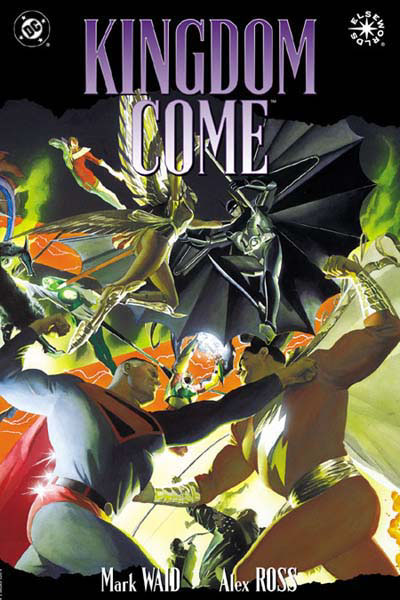 Not just a celebration of Superman, but the entire DC Universe, Mark Waid and Alex Ross might set their story in an Elseworlds future, but it’s hard to imagine a better ending to the golden age of superheroes than this. We went through this one all the way back in issue #10 of the Behind the Panels podcast. Like the earlier Marvels, it is told almost entirely from the perspective of Everyman Norman McCay. It’s been a decade since the classic superheroes have appeared, giving way to new superhero named Magog, who has no issues with killing. The younger generation of meta-humans fight amongst themselves with callous regard towards human lives, until Superman is convinced to return and reform the Justice League. The resulting metahuman civil war leads to significant destruction, like the Man of Steel, but also a new era of peace between humans and metahumans. As wonderful as the story is, it is Alex Ross who is the superhero here, delivering page after page of gorgeous painted art, based largely on people he knew. Minister Clark Norman Ross, the artist’s father, posed for the likeness of Norman McCay, and the proximity to his subject is evident in the love and attention given to this character. Not necessarily one for DC initiates, but if you make it all the way through this list, it’s a good place to end it on. Before going out to find more comics, of course.
Not just a celebration of Superman, but the entire DC Universe, Mark Waid and Alex Ross might set their story in an Elseworlds future, but it’s hard to imagine a better ending to the golden age of superheroes than this. We went through this one all the way back in issue #10 of the Behind the Panels podcast. Like the earlier Marvels, it is told almost entirely from the perspective of Everyman Norman McCay. It’s been a decade since the classic superheroes have appeared, giving way to new superhero named Magog, who has no issues with killing. The younger generation of meta-humans fight amongst themselves with callous regard towards human lives, until Superman is convinced to return and reform the Justice League. The resulting metahuman civil war leads to significant destruction, like the Man of Steel, but also a new era of peace between humans and metahumans. As wonderful as the story is, it is Alex Ross who is the superhero here, delivering page after page of gorgeous painted art, based largely on people he knew. Minister Clark Norman Ross, the artist’s father, posed for the likeness of Norman McCay, and the proximity to his subject is evident in the love and attention given to this character. Not necessarily one for DC initiates, but if you make it all the way through this list, it’s a good place to end it on. Before going out to find more comics, of course.

